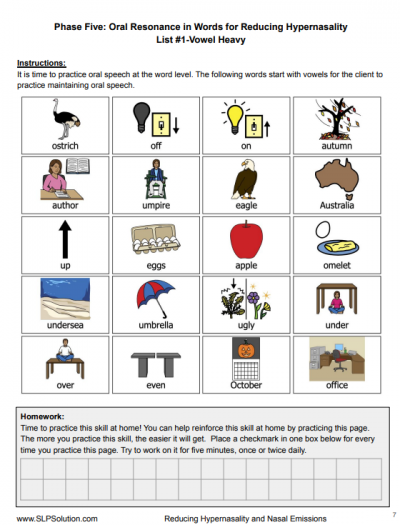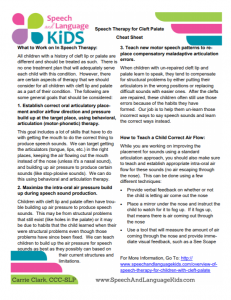Hypernasality Speech Therapy: Treatment Ideas for Hypernasal Speech
Hypernasality occurs when a child speaks with too much nasal resonance. Airflow tends to be directed up into the nasal cavity during speech instead of primarily through the oral cavity. Nasal emission is when that air comes all the way out through the nose. This can make a puffing or noisy sound in the nose during speech. Here are the steps for therapy for both hypernasality and nasal emission.
Listen to the Podcast on Hypernasality Speech Therapy:
Hypernasality Speech Therapy Goals:
Check out this sample goal for hypernasality speech therapy! Keep in mind, you should modify this goal to meet the needs of each individual client or patient that you’re working with:
The patient will demonstrate appropriate oral and nasal resonance during a 30 minute unstructured conversation in 2 speaking settings with no more than 2 instances of hypernasality.
Therapy Phases for Hypernasality Speech Therapy:
- Refer to ENT: All clients who exhibit voice issues should be referred to an ENT first to check the structures and functions and be cleared for therapy. If hypernasality is present, it may be secondary to a cleft palate and would need to be addressed first.
- Discriminate Between Oral Vs. Hypernasal: The client will be able to discriminate between appropriate oral resonance and hypernasality during speech after listening to a speaker (live or recorded) 85% of the time independently on 3 out of 4 data collection days.
- Technique Practice: After the effective technique has been identified in therapy, the client will practice that technique.
- Oral Resonance in Vowels: The client will use oral resonance when saying vowels 80% of the time with no more than 2 cues on 3 out of 4 data collection days.
- Oral Resonance in Words: The client will use oral resonance in words 80% of the time with no more than 2 cues on 3 out of 4 data collection days.
- Oral Resonance in Phrases : The client will use oral resonance in phrases 80% of the time with no more than 2 cues on 3 out of 4 data collection days
- Oral Resonance in Sentences: The client will use oral resonance in sentences 80% of the time with no more than 2 cues on 3 out of 4 data collection days.
- Oral Resonance when Reading: The client will use oral resonance when reading aloud independently 80% of the time with no more than 2 cues on 3 out of 4 data collection days.
- Oral Resonance in Conversation: The client will independently use oral resonance during conversation in the therapy setting with no more than 2 cues on 3 out of 4 data collection days.
- Generalize Oral Air Flow to Other Environments: Student will use correct oral airflow in a variety of situations and environments.
*** Discontinue Therapy if Not Making Progress: If no progress is made after 6 weeks, client should be re-evaluated by ENT.
Therapy Activities and Techniques for Hypernasality
- Stimulability probe: Try to get the child to imitate oral resonance
- Altering Tongue Position: Try for a lower, posterior tongue placement
- Open Mouth: Have the child speak with his mouth more open
- Change Volume: Try different volumes to see which has less nasality
- Change Pitch: Try different pitches to see which has less nasality
- Auditory Feedback: Teach the child to hear the difference between nasal and oral resonance in himself and others
- Feedback: Tell the child if productions are oral or nasal so he can learn to feel the difference
- Focus on the Facial Mask Area: Have the child draw his focus and attention to the eyes/nose area of his face
- Bio-feedback: Give the child immediate feedback on if air is coming out of the nose like placing a mirror right below nose or using a See Scape
Source:
The Voice and Voice Therapy, Seventh Edition: By Boone, McFarlane, and Von Berg

About the Author: Carrie Clark, MA CCC-SLP
Hi, I’m Carrie! I’m a speech-language pathologist from Columbia, Missouri, USA. I’ve worked with children and teenagers of all ages in schools, preschools, and even my own private practice. I love digging through the research on speech and language topics and breaking it down into step-by-step plans for my followers.
Connect with Me:
Podcast: Play in new window | Download | Embed
Subscribe: Apple Podcasts | RSS








Great podcast on hypernasality! It helps a lot knowing you did the research and made a podcast based off of it. It saved me hours of work! I really appreciate your podcast. Thanks!
Thanks, Elaine! We are super happy our podcast was of help to you!
Thank you for this podcast! My cleft team thinks my 4 1/2 year old son has hypernasality. I tried to access this URL for your materials as you suggested and it is not working…www.speechandlanguagekids.com/rtickit
Thank you!
Hi, Vega-Here is a link to a See-Scape device to order: https://www.proedinc.com/Products/2166/seescape-kit.aspx.
Thanks! Listened to the podcast today and I found it very useful! Going to implement some of these and see how we go.
That’s great, Nina! Please let us know if you have any questions.
Thank you! This was a great resource! It was so nice to have all the strategies listed in one place. I took lots of notes! I also enjoyed listening. Great job!
You are more than welcome, Karley! Please be in touch if you have any questions.
I just come through this podcast..it is informative..I am an ORL surgeon working overseas (Saudi Arabia)..my greetings
Great information on nasality!! I tried to access the show notes on the link you said, but the page comes up as “not found”. Is it possible to still get this?
Thanks so much!!
Hi, Sarah-
Unfortunately, I do not believe the show notes are still available. I’m so sorry about that!